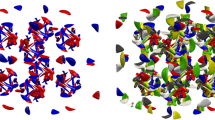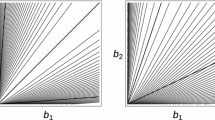We obtain attractor and inertial-manifold results for a class of 3D turbulent flow models on a periodic spatial domain in which hyperviscous terms are added spectrally to the standard incompressible Navier–Stokes equations (NSE). Let P m be the projection onto the first m eigenspaces of A =−Δ, let μ and α be positive constants with α ≥3/2, and let Q m =I − P m , then we add to the NSE operators μ A φ in a general family such that A φ≥Q m A α in the sense of quadratic forms. The models are motivated by characteristics of spectral eddy-viscosity (SEV) and spectral vanishing viscosity (SVV) models. A distinguished class of our models adds extra hyperviscosity terms only to high wavenumbers past a cutoff λ m0 where m 0 ≤ m, so that for large enough m 0 the inertial-range wavenumbers see only standard NSE viscosity.
We first obtain estimates on the Hausdorff and fractal dimensions of the attractor \({\mathcal{A}}\) (respectively \(\dim_{\rm H}{\mathcal{A}}\) and \(\dim_{\rm F}{\mathcal{A}}\)). For a constant K α on the order of unity we show if μ ≥ ν that \(\dim_{\rm H} {\mathcal{A}} \leq \dim_{\rm F} {\mathcal{A}} \leq K_{\alpha} \left[\lambda_{m}/\lambda_{1}\right]^{9\left(\alpha - 1\right)/(10\alpha)} \left[l_{0}/l_{\epsilon}\right]^{(6\alpha+9)/(5\alpha)}\) and if μ ≤ ν that \(\dim_{\rm H} {\mathcal{A}} \leq \dim_{\rm F} {\mathcal{A}} \leq K_{\alpha} \left(\nu/\mu\right)^{9/(10\alpha)}\left[\lambda_{m}/\lambda_{1}\right]^{9\left(\alpha -1\right)/(10\alpha)} \left[l_{0}/l_{\epsilon}\right]^{(6\alpha + 9)/(5\alpha)}\) where ν is the standard viscosity coefficient, l 0 = λ −1/21 represents characteristic macroscopic length, and \(l_{\epsilon}\) is the Kolmogorov length scale, i.e. \(l_{\epsilon} = (\nu^{3}/\epsilon)\) where \(\epsilon\) is Kolmogorov’s mean rate of dissipation of energy in turbulent flow. All bracketed constants and K α are dimensionless and scale-invariant. The estimate grows in m due to the term λ m /λ1 but at a rate lower than m 3/5, and the estimate grows in μ as the relative size of ν to μ. The exponent on \(l_{0}/l_{\epsilon}\) is significantly less than the Landau–Lifschitz predicted value of 3. If we impose the condition \(\lambda_{m} \leq (1/l_{\epsilon})^{2}\), the estimates become \(K_{\alpha} \left[l_{0}/l_{\epsilon}\right]^{3}\) for μ ≥ ν and \(K_{\alpha}\left(\nu/\mu \right)^{\frac{9}{10\alpha}}\left[l_{0}/l_{\epsilon}\right]^{3}\) for μ ≤ ν. This result holds independently of α, with K α and c α independent of m. In an SVV example μ ≥ ν, and for μ ≤ ν aspects of SEV theory and observation suggest setting \(\mu \thicksim c\nu\) for 1/c within α orders of magnitude of unity, giving the estimate \(c_{\alpha}K_{\alpha}\left[l_{0}/l_{\epsilon}\right]^{3}\) where c α is within an order of magnitude of unity. These choices give straight-up or nearly straight-up agreement with the Landau–Lifschitz predictions for the number of degrees of freedom in 3D turbulent flow with m so large that (e.g. in the distinguished-class case for m 0 large enough) we would expect our solutions to be very good if not virtually indistinguishable approximants to standard NSE solutions. We would expect lower choices of λ m (e.g. \(\lambda_{m}\thicksim a(1/l_{\epsilon})\) with a > 1) to still give good NSE approximation with lower powers on l 0/l ε, showing the potential of the model to reduce the number of degrees of freedom needed in practical simulations. For the choice \(\epsilon \thicksim \nu^{\alpha}\), motivated by the Chapman–Enskog expansion in the case m = 0, the condition becomes \(\lambda_{m}\leq \nu (1/l_{\epsilon})^{2}\), giving agreement with Landau–Lifschitz for smaller values of λ m then as above but still large enough to suggest good NSE approximation. Our final results establish the existence of a inertial manifold \({\mathcal{M}}\) for reasonably wide classes of the above models using the Foias/Sell/Temam theory. The first of these results obtains such an \({\mathcal{M}}\) of dimension N > m for the general class of operators A φ if α > 5/2.
The special class of A φ such that P m A φ = 0 and Q m A φ ≥ Q m A α has a unique spectral-gap property which we can use whenever α ≥ 3/2 to show that we have an inertial manifold \({\mathcal{M}}\) of dimension m if m is large enough. As a corollary, for most of the cases of the operators A φ in the distinguished-class case that we expect will be typically used in practice we also obtain an \({\mathcal{M}}\), now of dimension m 0 for m 0 large enough, though under conditions requiring generally larger m 0 than the m in the special class. In both cases, for large enough m (respectively m 0), we have an inertial manifold for a system in which the inertial range essentially behaves according to standard NSE physics, and in particular trajectories on \({\mathcal{M}}\) are controlled by essentially NSE dynamics.
Similar content being viewed by others
References
Avrin, J. Approximate globally-regular solutions of the Navier–Stokes equations via spectral methods, submitted.
Avrin J. (1996). Large-eigenvalue global existence and regularity results for the Navier–Stokes equation. J. Diff. Eqns. 12, 365–390
Avrin J. (2003). Singular initial data and uniform global bounds for the hyperviscous Navier–Stokes equations with periodic boundary conditions. J. Diff. Eq. 190, 330–351
Ball, J. (1997). Continuity properties and global attractors of generalized semiflows and the Navier–Stokes equations. J. Nonlinear Sci. 7, 475–502. Erratum: J. Nonlinear Sci. 8 (1998).
Borue V., Orszag S. (1996). Numerical study of three-dimensional Kolmogorov flow at high Reynolds numbers. J. Fluid Mech. 306, 293–323
Borue V., Orszag S. (1998). Local energy flux and subgrid-scale statistics in three-dimensional turbulence. J. Fluid Mech. 306, 1–31
Cerutti S., Meneveau C., Knio O.M. (2000). Spectral and hyper-eddy viscosity in high-Reynolds-number turbulence. J. Fluid Mech. 421, 307–338
Chen G.Q., Du Q., Tadmor E. (1993). Spectral viscosity approximations to multidimensional conservation laws. Math. Comp. 61, 629
Chollet, J. (1985). Two point closure used for a sub-grid scale model in LES. In Bradbury, J. L., Durst, F., Launder, B., Schmidt, F., and Whitelaw, J. (eds.), Turbulent Shear Flows, Vol. 4, Springer, pp. 62–72.
Chollet J., Lesieur M. (1981). Parametrization of small scales of three-dimensional isotropic turbulence utilizing spectral closures. J. Atmos. Sci. 38, 2747–2757
Constantin P., Foias C.F. (1985). Global Liapunov exponents, Kaplan-Yorke formulas and the dimension of the attractor for the 2-d Navier–Stokes equations. Com. Pure Appl. Math 38, 1–27
Constantin P., Foias C., Manley O., Temam R. (1985). Determining modes and fractral dimensions of turbulent flows. J. Fluid Mech. 150, 427–440
Constantin P., Foias C.F., Temam R. (1985). Attractors representing turbulent flows. Mem. Am. Math. Soc. 53, 114
Constantin P., Foias C., Temam R. (1988). On the dimension of the attractors in two dimensional turbulence. Phys. D 30, 284–296
Foias C., Holm D.D., Titi E.S. (2002). The three-dimensional viscous Camassa–Holm equations and their relation to the Navier–Stokes equations and turbulence theory. J. Dyn. Diff. Eqns. 14, 1–34
Foias, C., Manley, O., Rosa, R., and Temam, R. (2001). Navier–Stokes Equations and Turbulence. Cambridge University Press.
Foias C., Sell G.R., Temam R. (1985). Variétés inertielles des équations differentielles dissipatives. C.R. Acad. Sci. Paris, Sér I. 301, 139–142
Foias C., Sell G.R., Temam R. (1988). Inertial manifolds, for nonlinear evolutionary equations. J. Diff. Eqns. 73, 309–353
Holm D.D., Marsden J.E., Ratiu T.S. (1998). Euler-Poincaré equations and semidirect products with applications to continuum theories. Adv. Math. 137, 1–81
Holm D.D., Marsden J.E., Ratiu T.S. (1998). Euler-Poincaré models of ideal fluids with nonlinear dispersion. Phys. Rev. Lett. 80, 4173–4176
Karamanos G.S., and Karniadakis G.E. (2000). A spectral vanishing viscosity method for large-eddy simulations. J. Comp. Phys. 163, 22–50
Kolmogorov A.N. (1941). The local structure of turbulence in incompressible viscous fluid for very large Reynolds numbers. C.R. (Doklady) Acad. Sci. URSS. 30, 301–305
Kraichnan R.H. (1967). Inertial ranges in two-dimensional turbulence. Phys. Fluids. 10, 1417–1423
Kraichnan R.H. (1976). Eddy viscosity in two and three dimensions. J. Atmos. Sci. 33, 1521–1536
Kukavica I. (1995). Level sets of the vorticity and the stream function for the 2D periodic Navier–Stokes equations with potential forces. J. Diff. Eq. 126, 374–388
Kukavica I. (2003). Length of vorticity nodal sets for solutions of the 2D Navier–Stokes equations. Comm. PDE 28, 771–793
Landau L., Lifschitz E. (1953). Fluid Mechanics. Addison-Wesley, New York
Marsden J.E., Shkoller S. (2002). The anisotropic Lagrangian-averaged Euler and Navier–Stokes equations. Arch. Rat. Mech. Anal. 166, 27–46
Sell G.R. (1996). Global attractors for the three-dimensional Navier–Stokes equations. J. Dynam. Diff. Eqns. 8, 1–33
Tadmor E. (1989). Convergence of spectral methods for nonlinear conservation laws. SIAM J. Nimer. Anal. 26, 30
Temam R. (1985). Attractors for Navier–Stokes equations. Nonlinear Partial Differential Equations and Their Applications. In: Brézis H., Lions J.L. (eds). Séminaire du Collège de France, Vol. 7. Pittman, Boston, pp. 272–292
Temam, R. (1986). Infinite-dimensional dynamical systems in fluid mechanics. In Browder, F. (ed.), Nonlinear Functional Analysis and its Applications. Proc. Sympos. Pure Math., Vol. 45, Amer. Math. Soc., Providence, RI, pp. 40–45.
Temam R. (1996). Infinite-Dimensional Dynamical Systems in Mechanics and Physics. Springer-Verlag, New York
Author information
Authors and Affiliations
Corresponding author
Rights and permissions
About this article
Cite this article
Avrin, J. The Asymptotic Finite-dimensional Character of a Spectrally-hyperviscous Model of 3D Turbulent Flow. J Dyn Diff Equat 20, 479–518 (2008). https://doi.org/10.1007/s10884-007-9100-3
Received:
Revised:
Published:
Issue Date:
DOI: https://doi.org/10.1007/s10884-007-9100-3




